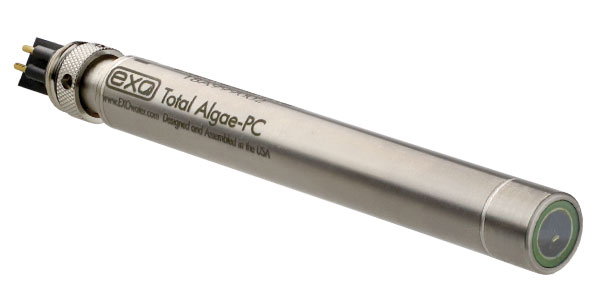How YSI Sensors Measure Chlorophyll
One key characteristic of chlorophyll is that it fluoresces. When irradiated with light of a particular wavelength, it emits light of a higher wavelength (or lower energy). The ability of chlorophyll to fluoresce is the basis for all commercial fluorometers capable of measuring the analyte in situ. These instruments induce chlorophyll to fluoresce by shining a beam of light of the proper wavelength into the sample and then measuring the higher wavelength light emitted due to the fluorescence process.
Most chlorophyll systems use a light-emitting diode (LED) as the source of the irradiating light; it has a peak wavelength of approximately 470 nm. LEDs with this specification produce radiation in the blue region of the visible spectrum. On irradiation with this blue light, chlorophyll emits light in the 650-700 nm region of the spectrum. To quantify the fluorescence, the system detector is usually a photodiode of high sensitivity that is screened by an optical filter that restricts the detected light. The filter prevents the 470 nm exciting light from being detected when it is backscattered off particles in the water. Without the filter, turbid (cloudy) water would appear to contain fluorescent phytoplankton, even though none were present.
Most commercial fluorometers fit into two categories:
- Benchtop instruments generally have superior optical flexibility and capability. Still, they are relatively expensive and can be difficult to use in the field.
- The less expensive field-type fluorometers with a fixed optical configuration can be more easily used in the field and are usually compatible with data collection platforms.
Using a pump is generally recommended for benchtop and field-type fluorometers, which can require large-capacity batteries for field use. These types of fluorometers have other disadvantages. For example, they can only give chlorophyll (fluorescence) readings and cannot measure any other water quality parameter. Also, the output is in mV or fluorescence units, not μg/L.

The Total Algae sensors for our EXO and ProDSS instruments are ideal for in situ monitoring of chlorophyll.
YSI’s unique Total Algae sensors consist of a probe similar in concept to the field-type fluorometers but much smaller, making them compatible with the probe ports of the EXO and ProDSS. These instrument platforms offer the ability to measure multiple water quality parameters alongside chlorophyll measurements—such as dissolved oxygen, temperature, pH, and more—for manual, discrete sampling or unattended, continuous monitoring. EXO and ProDSS Total Algae sensors are also two sensors in one, combining chlorophyll measurements with either phycocyanin or phycoerythrin, pigments common in cyanobacteria, using dual-channel LED technology.
The output of the Total Algae sensor is automatically processed via the instrument software to provide readings in relative fluorescence units (RFU) or µg/L of chlorophyll. A more quantitative output of cells/mL can also be achieved by generating a correlation coefficient in Kor Software using laboratory-analyzed grab samples. In addition, no pump is required, allowing the sensor to operate from either the sonde internal batteries or the batteries in a display/logger.
To learn more, check out our blog on How Algae Sensors Work | Answers to Four Challenging Questions.

Fouling Effects on Optical Measurements
Field optical measurements are particularly susceptible to fouling. This can occur from the long-term buildup of biological and chemical debris and/or the short-term formation of bubbles from the outgassing of the environmental water. In short-term sampling applications, these bubbles can generally be removed by simply agitating the probe manually.
A mechanical wiper—such as the Central Wiper for the EXO—is ideal for unattended applications. The wiper can be activated in real time during discrete sampling operations or function automatically during long-term unattended monitoring studies. The number of wiper movements and the cleaning cycle frequency for the unattended mode can be set in the EXO Sonde software. Generally, one wipe cycle per measurement is sufficient for most applications, but more frequent cleaning cycles may be necessary in environments with particularly heavy fouling.
Do you have questions about chlorophyll or need help selecting a measurement solution? Ask our experts or schedule a free virtual consultation today!